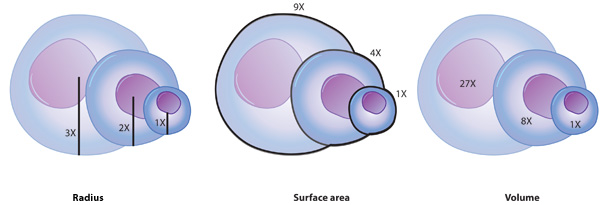
So what we can see here as the cube gets bigger, the surface area goes up. But at the same time, the volume goes up faster. As a result the SA/volume gets smaller.
As I was saying earlier, the membrane is the entry and exit point for substances for a cell. So if the amount of membrane available to service a unit of cytoplasm inside the cell gets smaller, it may get to the point where a cell can get required materials in fast enough and/or remove its wastes. As a result, there is a size "wall" that cells hit pretty quickly. As a result the size a cell can get to before it runs into these problems is pretty small (microscopic in fact).
Lets have another look with shapes that look more "cell-like"

So once again you can see that even though the surface area increases as the cell gets bigger, the volume increases at an even faster rate. And once again, there comes a point where the cell cannot sustain itself because it cant get enough materials in and out.
When we look at whole organisms, the scenario varies depending on what we are looking at. Take bear 2, the Sun Bear of tropical south east Asia. It has a thin build and comparatively slender limbs. This means has a high SA/vol ratio and can lose enough heat as to live in the jungle.
The top left bear around 6 is a Brown Bear found in mainland USA. The bottom right one is a Brown Bear from Alaska (considerably northwards and colder). Then have a look at the Polar Bear. How does SA/Vol alter?

The bigger you are, then the colder you can tolerate things. A small Sun Bear would freeze in Alaska or other polar regions, while the larger bears are fine. Conversely, the big bears would struggle in the tropics which suit the small bear. So SA/Vol ratios are important not only on a microscopic scale but a macroscopic scale as well. This will be looked at in other parts of this course, in the Prelim and HSC.
No comments:
Post a Comment